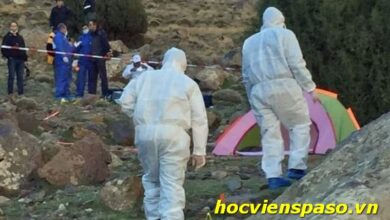Dawn Therese Brancheau Footage and the SeaWorld incident

In the realm of marine entertainment, the haunting “Dawn Therese Brancheau Footage” is a somber reminder of a tragic incident at SeaWorld Orlando that forever changed views on the relationship between humans and marine animals. In this article, hocvienspaso.vn delves into the heartbreaking details of the incident, its consequences, and its profound impacts on SeaWorld, the captive animal farming industry, and society as a whole.
I. Unpredictability when working with wildlife
The tragic ending on February 24, 2010, of the “Dine with Shamu” show at SeaWorld, where veteran trainer Dawn Brancheau lost her life to Tilikum, highlighted the unpredictability inherent in working with wild animals. Despite Brancheau’s extensive experience, the incident highlighted the challenges of managing the behavior of creatures as large and intelligent as orcas. Dawn Therese Brancheau Footage captures the macabre moments leading up to the tragedy, serving as a stark reminder of the dynamic nature of these animals and the potential risks associated with close human interactions. people and animals.

II. Aftermath at SeaWorld Following the Dawn Therese Brancheau Footage:
The release of the Dawn Therese Brancheau footage had profound repercussions for SeaWorld, triggering a series of significant events that reshaped the marine entertainment industry. The incident, captured in chilling detail, reverberated across the park, leaving both the staff and visitors in shock.
In response to the widespread media coverage and intense public scrutiny, SeaWorld made the immediate decision to close its doors. The gravity of the situation demanded a pause in operations as the park grappled with the tragic consequences of the incident. The closure was not only a practical measure but also a symbolic acknowledgment of the need for reflection and reassessment.
Dawn Therese Brancheau Footage, which documented the chilling moments leading up to the tragedy, became a focal point for discussions surrounding the safety and ethical implications of keeping marine mammals in captivity. The emotional impact on SeaWorld’s community was profound, with a deep sense of sadness permeating the atmosphere as everyone connected with the park mourned the loss of a respected and experienced trainer.

In the wake of the incident and the subsequent closure, SeaWorld found itself at the center of a storm of public opinion. The footage served as a catalyst for intensified debates on the ethical treatment of marine animals in captivity and the broader question of using these creatures for human entertainment. Advocacy groups seized the opportunity to call for reforms, and the incident prompted a reevaluation of SeaWorld’s practices, policies, and the role of marine parks in general.
The closure of SeaWorld reflected a recognition of the need for transparency, accountability, and a commitment to the well-being of both trainers and marine animals. It marked a turning point in the way marine parks operated, as the industry faced increasing pressure to prioritize the welfare of its animal residents and reconsider the ethics of their practices in the wake of such a tragic and publicized event.
III. Response and consequences of the incident:
1. SeaWorld’s response:
Following the tragic Dawn Therese Brancheau Footage and Tilikum incidents, SeaWorld initiated a comprehensive internal investigation. This critical examination of the events has led to a series of proactive measures aimed at preventing similar incidents in the future. The park has made significant improvements to training and safety protocols, recognizing the need to enhance protocols to ensure the health of both trainers and marine animals.
Furthermore, SeaWorld made significant changes to its whale shows as part of its response to the incident. These changes are not only aimed at ensuring trainer safety but also reflect a broader shift in the park’s approach to public presentation of marine animals. The incident served as a catalyst for a reassessment of the entertainment value derived from displaying these majestic creatures, motivating SeaWorld to adopt a more conscientious and responsible stance.

2. Government Investigation (OSHA):
In parallel with SeaWorld’s internal response, the Occupational Safety and Health Administration (OSHA) conducted an extensive investigation into the incident. This government investigation focused on evaluating workplace safety standards and practices within SeaWorld. The investigation ultimately resulted in SeaWorld being fined and fined.
The legal consequences of OSHA’s findings sparked a notable legal battle, as SeaWorld was held responsible for safety violations. This legal scrutiny marks an important moment in the ongoing dialogue about the ethics and safety of marine mammal captivity. Fines and citations are a tangible consequence, signaling the importance of adhering to strict safety standards in the marine recreation industry.
Overall, the incident prompted a paradigm shift in how SeaWorld and the broader industry approached animal training, safety and public performances. The combination of internal reform and external regulatory action underscores the need for responsible and ethical considerations in the treatment of both trainers and captive marine animals. .
IV. Public Outcry and Activism:
The emergence of the “Dawn Brancheau Ponytail Video” has triggered a wave of public outrage and heightened activism, particularly within animal rights organizations such as PETA. The graphic nature of the video has fueled widespread concern for the ethical treatment of animals, with many expressing their dismay and anger over the conditions faced by captive animals.
In response to this public outcry, various advocacy groups have seized the opportunity to shed light on the broader issue of animal captivity. PETA, in particular, has spearheaded campaigns and organized protests to raise awareness about the challenges faced by marine animals held in captivity. The focus of these efforts extends beyond the tragic incident captured in the video, aiming to address systemic problems within the entertainment industry and facilities that keep marine mammals.
V. Advocacy for Ethical Treatment of Animals:
Animal rights organizations, especially PETA, have intensified their efforts to advocate for the ethical treatment of animals in captivity. Their campaigns emphasize the need for stricter regulations and ethical guidelines governing the treatment of marine mammals in theme parks, aquariums, and other entertainment venues. The public outcry has provided a platform for these organizations to amplify their message and garner support for reforms in the industry.
VI. Protests and Campaigns:
In response to the shocking video, PETA and other animal rights groups have organized protests and campaigns to demand change. Activists have taken to the streets, voicing their concerns about the well-being of marine animals and calling for an end to practices that they deem cruel and inhumane. Social media has played a pivotal role in spreading awareness, with hashtags and viral campaigns amplifying the message and encouraging a broader audience to join the cause.
These demonstrations aim not only to express discontent over the specific incident but also to push for legislative changes that address the broader ethical concerns surrounding animal captivity. The ultimate goal is to create a groundswell of support for laws that prioritize the welfare of animals, challenging industries that profit from their captivity.
In conclusion, the release of the “Dawn Therese Brancheau Footage” has galvanized public opinion and sparked a renewed wave of activism in favor of the ethical treatment of animals. As organizations like PETA continue to champion the cause, the hope is that these efforts will lead to lasting changes in legislation and industry practices, ensuring a more humane treatment of animals in captivity.








